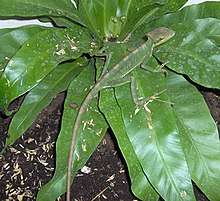Eastern casquehead iguana
The eastern casquehead iguana (Laemanctus longipes) is a species of lizard in the family Corytophanidae. The species is endemic to Central America and Mexico.
| Eastern casquehead iguana | |
|---|---|
.jpg) | |
| Laemanctus longipes | |
| Scientific classification | |
| Kingdom: | Animalia |
| Phylum: | Chordata |
| Class: | Reptilia |
| Order: | Squamata |
| Suborder: | Iguania |
| Family: | Corytophanidae |
| Genus: | Laemanctus |
| Species: | L. longipes |
| Binomial name | |
| Laemanctus longipes | |
Geographic range
L. longipes is found in southern Mexico (Colima, Oaxaca, Veracruz, Yucatán), Belize, Guatemala, Honduras, and Nicaragua.[2]
Description
Long and thin, L. longipes can reach 70 cm (27.5 in) in total length, two-thirds of which is a thin tail.
The scales on the forehead are much larger than those on the back of the head. No projecting triangular scales occur on the posterior border of the head. The gular scales are bicarinate or tricarinate.[3]
Sexual dimorphism is present, but is difficult to observe. Males have a somewhat thicker tail root than females, and the hemipenes are sometimes visible when lifting the tail gently.
Habitat
The eastern casquehead iguana inhabits tropical wet, moist, and seasonally dry forests. It can persist in secondary growth when suitable trees are present.[1]
Behavior
The eastern casquehead iguana is an arboreal species occurring high up in the trees.[1] Rather slow, it sits on trees and bushes above water courses, licking water drops on leaves, and catching insects that walk nearby. L. longipes lives individually, or in a territory with one male and one to three females. Usually, however, males and females only meet for mating, which can happen several times per year.
Subspecies
Two subspecies are recognized, including the nominotypical subspecies.[2]
Etymology
The subspecific name, deborrei, is in honor of Belgian entomologist Alfred Preudhomme de Borre (1833–1905).[4][5] The subspecific name, waltersi, is in honor of Leon L. Walters, who collected the type specimen with Karl P. Schmidt.[6]
Captivity

.jpg)
The eastern casquehead iguana is sometimes bred in captivity, but it is not a good terrarium companion for beginners, as it quickly and often dehydrates. Daily misting or a water-dropping system is essential. Temperatures should range between 25 and 35 °C (77 and 95 °F) during the day, and between 20 and 23 °C (68 and 73.4 °F) during the night. Humidity should range between 70 and 90%. L. longipes is a great cricket eater and should receive at least four or five adult crickets every day. It also needs UVA and UVB lighting and an additional vitamin and calcium feed once a week.
References
- Flores-Villela O, Townsend JH, Wilson LD (2013). "Laemanctus longipes ". IUCN Red List of Threatened Species. 2013: e.T197492A2490065. doi:10.2305/IUCN.UK.2013-2.RLTS.T197492A2490065.en.CS1 maint: multiple names: authors list (link)
- Laemanctus longipes at the Reptarium.cz Reptile Database. Accessed 9 April 2015.
- Boulenger GA (1885). Catalogue of the Lizards in the British Museum (Natural History). Second Edition. Volume II. Iguanidæ ... London: Trustees of the British Museum (Natural History). (Taylor and Francis, printers). xiii + 497 pp. + Plates I-XXIV. (Læmanctus longipes, pp. 105-106).
- Beolens, Bo; Watkins, Michael; Grayson, Michael (2011). The Eponym Dictionary of Reptiles. Baltimore: Johns Hopkins University Press. xiii + 296 pp. ISBN 978-1-4214-0135-5. (Laemanctus longipes deborrei, p. 67).
- "Alfred Preudhomme de Borre 1833-1905". Scarab Workers World Directory. www.museum.unl.edu/research/entomology//workers/APreudhomme.htm
- Schmidt KP (1933). "New Reptiles and Amphibians from Honduras". Field Mus. Nat. Hist. Zool. Ser. 20 (4): 15-22. (Laemanctus waltersi, new species, pp. 20-21).
Further reading
- Boulenger GA (1877). "Étude monographique du genre Læmanctus et description d'une espèce nouvelle ". Bulletin de la Société Zoologique de France 2: 460-466 + Plate VII. ("Læmanctus de Borrei ", new species, pp. 465–466 + Plate VII, figures 1, 1a, 1b). (in French).
- McCoy CJ (1968). "A review of the genus Laemanctus (Reptilia, Iguanidae)". Copeia 1968 (4): 665-678.
- Wiegmann AFA (1834). Herpetologia Mexicana, seu Descriptio Amphibiorum Novae Hispaniae, quae Itineribus Comitis de Sack, Ferdinandi Deppe et Chr. Guil. Schiede in Museum Berolinense Pervenerunt. Pars Prima, Saurorum Species Amplectens. Adiecto Systematis Saurorum Prodromo, Additisque Multis in hunc Amphibiorum Ordinem Observationibus. Berlin: C.G. Lüderitz. vi + 54 pp. + Plates I-X. (Laemanctus longipes, new species, pp. 46–47 + Plate IV). (in Latin).
